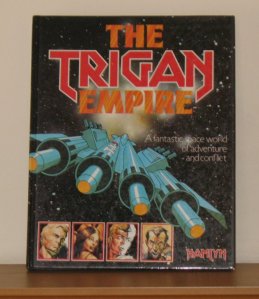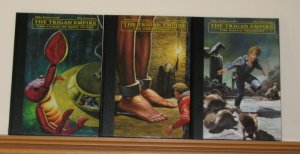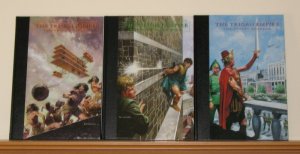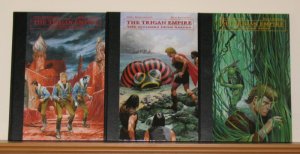About three weeks ago, the BBC published a list of “100 Books That Shaped Our World”, comprising titles chosen by a panel “of leading writers, curators and critics”, otherwise known as a radio presenter and literary supplement editor, a broadcaster, three authors and the director of a literary festival. As lists go, it’s a bit, well, establishment, choosing minor titles from contemporary fiction and clonking great bestsellers from genre fiction. A few days later, Nina Allan published a rival list on her blog, and called for others to do the same. Some of my friends have followed her lead.
I like lists. I’ve made no secret of the fact. I’m even responsible for creating one or two that have gone viral, such as the SF Mistressworks list, or the 100 Great Science Fiction Stories by Women list. So, of course, I decided to have a go myself. But putting together a list of 100 novels which have shaped a person’s reading is hard. Even if you have recorded pretty much everything you’ve read (or, for me, back to the start of the 1990s).
I decided instead to produce an annotated list. And I would organise the list by the decade – one decade per post – during which I encountered the books, giving a sort of history of my reading. While I’d stick to the one book per author “rule”, I wouldn’t limit myself to novels.
It still wasn’t easy. But I managed to put something together. It’s sort of in the order I encountered each book. For the 1970s and 1980s (see next post), it can’t be exact as I didn’t record my reading then. And my recall is good but not that good.
So here is the first installment:
The 1970s
 The Golden Bird, Jan Pieńkowski & Edith Brill (1970). I don’t actually recall the books I read before the age of eight or nine, but I do have a vivid memory of this one, particularly its illustrations. Until looking up titles for this post I had, however, thought it was by Joan Aiken, who I do recall reading back then – but not which of her titles.
The Golden Bird, Jan Pieńkowski & Edith Brill (1970). I don’t actually recall the books I read before the age of eight or nine, but I do have a vivid memory of this one, particularly its illustrations. Until looking up titles for this post I had, however, thought it was by Joan Aiken, who I do recall reading back then – but not which of her titles.
The Weirdstone of Brisingamen, Alan Garner (1960). This was a British children’s classic for many years and, like many of the books I encountered prior to my eleventh birthday, I read and loved it before understanding what science fiction or fantasy actually were.
Destination Moon, Hergé (1950). I can’t be the only sf fan who was influenced by this when they first read it? Hergé’s star has grown somewhat tarnished in the decades since he died – for the early racist stories, deservedly so – but Destination Moon introduced the iconic rocket that is still recognised the world over today.
 Edgar Rice Burrough’s Tarzan of the Apes, Burne Hogarth (1972). I’ve no idea why I have such a strong memory of this book – it was the 1974 Pan paperback edition – but I was big on Tarzan around the age of eight or nine or ten. Perhaps because the Tarzan television series starring Ron Ely was a fixture on Dubai’s Channel 33 at the time. I also have a very strong memory of reading a Tarzan annual – I later tracked it down as the 1973 annual – in a hotel in London, probably because it was the day before I had an orthodontic brace fitted and that kind of gets seared into your memory.
Edgar Rice Burrough’s Tarzan of the Apes, Burne Hogarth (1972). I’ve no idea why I have such a strong memory of this book – it was the 1974 Pan paperback edition – but I was big on Tarzan around the age of eight or nine or ten. Perhaps because the Tarzan television series starring Ron Ely was a fixture on Dubai’s Channel 33 at the time. I also have a very strong memory of reading a Tarzan annual – I later tracked it down as the 1973 annual – in a hotel in London, probably because it was the day before I had an orthodontic brace fitted and that kind of gets seared into your memory.
The Red Moon Mystery, Frank Hampson (1951). One Christmas in the early 1970s, my parents bought me the Hamlyn Dan Dare 1974 annual, which contained ‘The Red Moon Mystery’ and ‘Safari in Space’. I loved it. And it made me a lifelong fan of the adventures of Colonel Daniel McGregor Dare. The book was badly damaged by mice or rats while in storage in the 1980s, but I still hung onto it for a couple of decades afterwards.
 Doctor Who and the Zarbi, Bill Strutton (1965). This is the first of the two novels which, I think, led to me identifying as a science fiction fan. My parents bought it me for Christmas in, I think, 1975. I had seen very few episodes of Doctor Who because I only spent the summers in the UK. For several years after being given this book, my relatives would buy Doctor Who novelisations published by Target as birthday and Christmas presents.
Doctor Who and the Zarbi, Bill Strutton (1965). This is the first of the two novels which, I think, led to me identifying as a science fiction fan. My parents bought it me for Christmas in, I think, 1975. I had seen very few episodes of Doctor Who because I only spent the summers in the UK. For several years after being given this book, my relatives would buy Doctor Who novelisations published by Target as birthday and Christmas presents.
Starman Jones, Robert A Heinlein (1953). In my first year at boarding-school – I was eleven – a boy in the same class lent me Starman Jones following a conversation. I had never read category sf before. As soon as I finished it, I wanted more…
 Gray Lensman, EE Doc Smith (1951) … and, fortunately, there was another boy at the school – in the year below me – who was an actual sf fan, and lent me some of his books, which he kept in his locker. True, it was EE ‘Doc’ Smith and Asimov… I don’t remember if I read the Lensman books in the correct order… but Gray Lensman I recall being the most exciting of the novels. I also loved the Chris Foss cover art on the books.
Gray Lensman, EE Doc Smith (1951) … and, fortunately, there was another boy at the school – in the year below me – who was an actual sf fan, and lent me some of his books, which he kept in his locker. True, it was EE ‘Doc’ Smith and Asimov… I don’t remember if I read the Lensman books in the correct order… but Gray Lensman I recall being the most exciting of the novels. I also loved the Chris Foss cover art on the books.
The Trigan Empire, Don Lawrence & Mike Butterworth (1965). The same school had a subscription to Look & Learn, a “weekly educational magazine for children”, which included in each issue some pages from the The Trigan Empire sf comic strip. I also had a copy of the Hamlyn The Trigan Empire omnibus published in 1978, but that must have come a year or two later.
Jack of Eagles, James Blish (1952)
Time and Again, Clifford D Simak (1951)
Tactics of Mistake, Gordon R Dickson (1971). These three novels are ones I remember loving during the 1970s. Blish and Simak were also authors I collected then. I no longer read them, although the novels here by them I did reread this century. I’m not entirely sure what I originally saw in them. The Dickson survived an adult reread much better, perhaps because I was more forgiving of its flaws. I still sort of like the Dorsai books, but I wouldn’t hold them up as especially good novels. Fortunately, that’s not what this list is about.
 Final Stage, Edward L Ferman & Barry N Malzberg (1974). I think I received this as a present. I don’t think the person who bought it knew what it contained, because some of the contents were a bit adult for a twelve year old. The anthology contains one of my favourite sf stories, Philip K Dick’s ‘A Little Something for Us Tempunauts’, and probably the only Harlan Ellison story I’ve ever really liked, ‘Catman’.
Final Stage, Edward L Ferman & Barry N Malzberg (1974). I think I received this as a present. I don’t think the person who bought it knew what it contained, because some of the contents were a bit adult for a twelve year old. The anthology contains one of my favourite sf stories, Philip K Dick’s ‘A Little Something for Us Tempunauts’, and probably the only Harlan Ellison story I’ve ever really liked, ‘Catman’.
Dune, Frank Herbert (1966). I remember at boarding-school seeing another boy reading this and asking him about it. He told me it was good, I eventually got hold of a copy of my own and… well, every thirteen year old boy wants to be Paul Atreides. My opinion of the book has dimmed considerably in the decades since, but I still maintain it is one of the genre’s premier exercises in worldbuilding.
 Traveller: Characters & Combat, Marc Miller (1977). I should really include all three books of the original Traveller RPG box set, especially since I count a few quartets as a single “book” later in this list. A friend at school had bought Dungeons & Dragons Basic Edition (the one in the blue box) and we planned to start up a school RPG society. So I asked for the Traveller basic set – the three Little Black Books in a box – for Christmas… and I’ve been a fan of the game ever since. Its world-building is a bit of a grab-bag, but as a collaborative project that’s been added to for over forty years, it has a depth few other science fiction universes can match.
Traveller: Characters & Combat, Marc Miller (1977). I should really include all three books of the original Traveller RPG box set, especially since I count a few quartets as a single “book” later in this list. A friend at school had bought Dungeons & Dragons Basic Edition (the one in the blue box) and we planned to start up a school RPG society. So I asked for the Traveller basic set – the three Little Black Books in a box – for Christmas… and I’ve been a fan of the game ever since. Its world-building is a bit of a grab-bag, but as a collaborative project that’s been added to for over forty years, it has a depth few other science fiction universes can match.
Next up, the 1980s…






